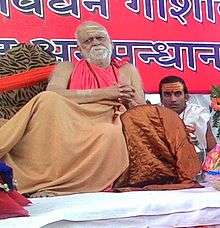Govardhan Math
Purvamnaya Sri Govardhana Peetham is one amongst the four cardinal peethams established by the 8th century philosopher-saint Adi Shankara to preserve and propagate Sanatana Dharma and Advaita Vedanta, the doctrine of non-dualism. Located in Puri in Odisha, India, it is the Eastern Amnaya Peetham amongst the four Chaturamnaya Peethams, with the others being the Sringeri Sharada Peetham (Karnataka) in the South, Dvaraka Kalika Peetham (Gujarat) in the West, and Badri Jyotishpeetham (Uttarakhand) in the North.[2] It is associated with the Jagannath temple[3]
| Acharya: Jagadguru Shankaracharya Swami Shri Nischalananda Saraswati | |
|---|---|
 | |
| Location | Puri |
| Founder | Adi Shankara |
| First Shankaracharya | Padmapadacharya |
| Present Shankaracharya | Swami Nischalananda Saraswati |
| Formation | 483 BCE[note 1] |
| Website | http://govardhanpeeth.org/ |

The deities here are Jagannath (Lord Vishnu) and the devi is Vimala (Bhairavi). The mahavakya is Prajnana Brahma. There are Shri Vigraha of Goverdhananatha Krishna and Ardhanareshwara Shiva installed by Adi Shankara.[4]
The whole of the Eastern part of the Indian subcontinent is considered as the territory of Sri Govardhan Peeth.[5] This includes the Indian states of Bihar, Jharkhand, Chhattisgarh, Andhra Pradesh till Rajamundry, Odisha, West Bengal, Assam, Arunachal Pradesh, Manipur, Sikkim, Meghalaya, Tripura, Mizoram, and Uttar Pradesh till Prayag. The countries Nepal, Bangladesh and Bhutan are also considered spiritual territory of the math . Puri, Prayagraj, Gaya and Varanasi are some of the holy places under this Math.
Background
Govardhana matha is one of four cardinal institutions established by Adi Shankara (c. 8th century CE), the reviver of Vedic Sanatana Dharma.[6] Shankara's four principal disciples, Padma-Pada, Hasta-Malaka, Vartika-Kara and Totakacharya were assigned to these four learning centers in the north, south, east and west of India.[7] The subsequent leaders of each of these four monasteries are known as Śaṅkarāchāryas in honor of the math's founder, Adi Shankara.[8] As such they are the leaders of the Daśanāmī Saṃnyāsins who are considered to have custody of Advaita Vedānta[8] These four principle seats of learning are located in Purī (Odisha), Śṛṅgeri (Karnataka) and Dvārakā (Gujarat) with[8] the northern (Uttarāmnāya) monastery being located in the city of Jyotirmaṭh (also known as Joṣīmaṭh).[8]
History
Padmapadacharya became the first leader of the matha. The matha has historical connections with the Jagannath temple, which is also located in Puri.[3] It is called the Govardhanathatha, and has sub-location called the Sankarananda Math.
Swami Bharati Krishna Tirtha, who was then the leader at the Dvaraka matha, assumed the leadership position at the Govardhana matha in 1925; Shankara Prushottama Tirtha supervised the Matha on his behalf while he visited the Self Realization Fellowship in the USA.[3] After Bharati attained Mahasamadhi in 1960, Yogeswaranda Tirtha succeeded him who also attained Mahasamadhi a year later in 1961. In 1964, after a "period of uncertainty" Niranjana Deva Tirtha, a disciple named in Bharati's will, was installed by Aghinava Saccindananda Tirtha of Dvarka.[3] Nirnjana Deva Tirtha became known for his unpopular political views affecting the Hindu people.[9] In 1992, he stepped down after nominating Niscalananda Saraswati as his successor.[3][10]
Niscalananda Saraswati was born in Darbhanga in 1943, the son of the raj-Pandita of Maharaja of Darabhanga.[11] He decided to enter sanyasa while being a student in the Tibbia College and spent time studying the shastras at Kashi, Vrindava, Naimisaranya, Shringeri etc. In 1974, he took diksha from Swami Karpatri who gave him name Niscalananda.
On 11 February 2018 silver jubilee (25th anniversary) of the pattabhisheka of Swami Nischalananda Saraswati was celebrated in Puri in the presence of chief minister Naveen Patnaik, former Nepal king Gyanendra Bir Bikram Shah Dev and Gajapati Maharaja Dibyasingha Deb of Puri.[12]
A person named Swami Adhokshyananda has sometimes claimed to be the Sankaracharya of Puri[13][14] He is known for having been invited by the American Federation of Muslims of India (AFMI) and by Shankersinh Vaghela in 2002.[15][16]
Samudra Arati

The Samudra arati is a daily tradition started by the present Shankaracharya 9 years ago.[4] The daily practise includes prayer and fire offering to the sea at Swargadwara in Puri by disciples of the matha. On Paush Purnima of every year the Shankaracharya himself comes out to offer prayers to the sea.
See also
- Adi Shankara
- Shankaracharya
- Kalady, Kerala - the holy birth place of Jagadguru Adi Shankaracharya
- Dwarka Sharada Peetham (West), Dwarka, Gujarat
- Jyotirmath Peetham (North), Badrikashram, Uttarakhand
- Shri Sringeri Sharada Peetham (South), Sringeri, Karnataka
- Shri Kanchi Kamakoti Peetham, Kancheepuram, Tamil Nadu
- Shri Gaudapadacharya Mutt
- Gaudapada
- Govinda Bhagavatpada
Notes
- According to traditional accounts it was established in 483 BCE.[1]
References
- govardhanpeeth.org
- J. Gordon Melton (2014). Faiths Across Time: 5,000 Years of Religious History. ABC-CLIO. pp. 574–575. ISBN 978-1-61069-026-3.
- Unknown author (5 May 1999) archived here (Accessed: 2012-08-30) or here The Monastic Tradition Advaita Vedanta web page, retrieved 28 August 2012
- Sahu, Monideepa (6 March 2016). "The great fire". Deccan Herald. Retrieved 6 March 2016.
- Vaidya, Dhananjay (17 August 2008). "Poorvamnaya Sri Govardhan Muth, Bhogavardhan Peetham, Puri". Organiser. Retrieved 16 November 2015.
- Pasricha, Prem C. (1977) The Whole Thing the Real Thing, Delhi Photo Company, p. 59-63
- Love and God, Maharishi Mahesh Yogi, Age of Enlightenment Press, 1973 p. 9
- Unknown author (2005) Indology The Jyotirmaṭha Śaṅkarācārya Lineage in the 20th Century, retrieved 4 August 2012
- http://www.rediff.com/news/2000/aug/28sankra.htm
- (1994) SUNY Press, A Survey of Hinduism By Klaus K. Klostermaier
- "जगतगुरु शङ्कराचार्य स्वामी निश्चलानंद जी महाराज, Biography, Govardhan Matha". Archived from the original on 22 September 2018. Retrieved 12 September 2018.
- Temple shut for king's visit, The Telegraph, 11 February 2018
- Rival Puri shankaracharya arrested, secures bail, Rediff, 17 July 2000
- Orissa HC allows seer to enter Puri, The Hindu, 6 September 2000
- [Shankaracharyas multiply, so do legal tangle, The Times of India]
- Shankaracharya is Cong’s weapon for BJP’s Hindutva war, Indian Express, 23 August 2002